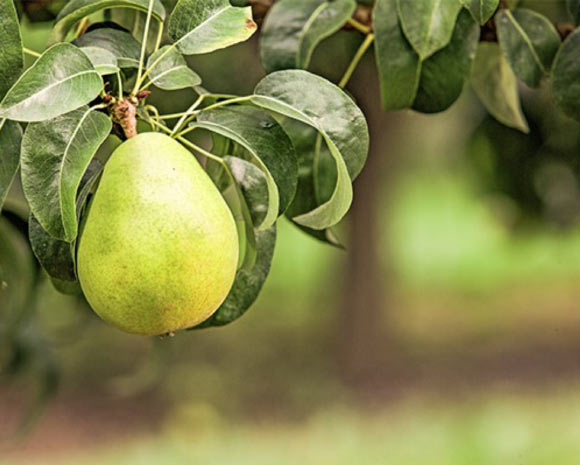Researchers from the HudsonAlpha Institute for Biotechnology and elsewhere have generated a chromosome-scale genome assembly for the d’Anjou pear, a short-necked cultivar of the European pear (Pyrus communis).
The European pear belongs to Pyrus, a genus in the family Rosaceae comprising cultivated and wild pears.
This genus is divided into two broad categories, the European and Asian pears, with their divergence estimated around 3-6 million years ago.
At least 26 Pyrus species and 10 naturally occurring interspecific crosses are now found in Western and Eastern Asia, Europe, North Africa, and the Middle East.
In 2021, the pear’s value of utilized production in the United States reached $353 million. This makes pear one of the most cultivated pome fruits worldwide.
One of the most important North American varieties of pear, the Anjou, also known as the Beurre d’Anjou or simply Anjou, is thought to have originated in Belgium, named for the Anjou region of France.
“Pears are big business in the Pacific Northwest U.S.,” said senior author Dr. Alex Harkess, a researcher with the HudsonAlpha Institute for Biotechnology, and colleagues.
“But did you know that traditional pear breeding has remained largely unchanged for centuries?”
“This slow process is difficult and costly, requiring the long-term commitment of labor, materials, and land-space resources.”
“However, traditional pear breeding might get some help from genomics, thanks to a unique collaboration between students, scientists, and the pear industry fostered through an initiative called the American Campus Tree Genomes (ACTG).”
“ACTG leverages iconic and economically valuable trees to bridge the gap between students and cutting-edge genomics.”
“Students collaboratively assemble, analyze, and publish tree genomes in prestigious journals, gaining invaluable experience.”
The meticulous work of the ACTG students yielded a fully phased chromosome-scale assembly of the d’Anjou pear — a significant advancement over previous efforts.
The assembly reveals thousands of genomic variants which are of great importance to pear breeding efforts.
This high-quality resource unlocks a treasure trove of information for pear breeders.
The assembly is also an important tool for studies on the evolution, domestication, and molecular breeding of pear.
“The ACTG program not only built high-quality genomic resources for a valuable pear cultivar that will ultimately benefit growers and consumers alike, but it educated nearly 20 students and scientists in the needs of the apple and pear industry,” said Dr. Ines Hanrahan, executive director of the Washington Tree Fruit Research Commission.
The team’s paper was published in the journal G3: Genes, Genomes, Genetics.
_____
Alan Yocca et al. 2024. A chromosome-scale assembly for ‘d’Anjou’ pear. G3: Genes, Genomes, Genetics 14 (3): jkae003; doi: 10.1093/g3journal/jkae003


